This month we bring you a bumper edition, packed full of all our favourite bits from the past four years.
In this episode
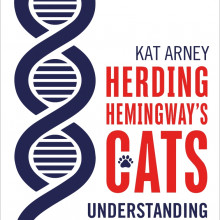
00:58 - Book - Herding Hemingway's Cats
Book - Herding Hemingway's Cats
with Kat Arney
Kat: First, as well as bringing you the Naked Genetics podcast every month, I've also been busy over the past couple of years researching and writing my debut book about genetics, called Herding Hemingway's Cats. Published by Bloomsbury Sigma it's out today in paperback, hardback and Kindle version from all online retailers and maybe even some real-life bookshops too. And there's even an audiobook too, read by me with some rather dodgy accents, I have to admit.
So what's it all about? Well, the language of genes has become common in the media. We know they make your eyes blue, your hair curly or your nose straight. We're told that genes control the risk of cancer, heart disease, alcoholism or Alzheimer's. The cost of DNA sequencing has plummeted from billions of pounds to a few hundred, and gene-based advances in medicine hold huge promise. With the help of cats with thumbs, fish with hips and wobbly worms as well as interviews with many of the leading genetics researchers around the world - I unpack some of the mysteries in our DNA and explain the latest thinking about how our genes work
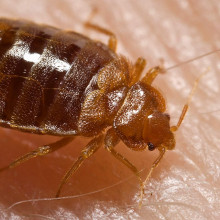
02:10 - Best of NG - Bedbug genetics
Best of NG - Bedbug genetics
with Toby Fountain, Sheffield university
Kat - The first interview I'm featuring is from October 2012, and it's one I'll never forget. Toby Fountain from the University of Sheffield was responsible for one of the least pleasant experiences I'd had for a long time, when he took me into the bedbug breeding room in his lab. I asked him to explain the growing bedbug threat, how genetics can help us to understand infestations, and what we can do to prevent picking up these unwanted invaders.
Toby - Bedbugs were pretty much everywhere until about 1940 and then with the introduction of better public health legislation and powerful insecticides, they were pretty much wiped out across the western world. Then we found that just after 2000, reports started resurfacing again, and it looks like the bedbugs are now making a bit of a comeback. But it's become a bit of a mystery. No one really knows why. Why now? Why have they been in obscurity and then suddenly come out? So, what my research is basically looking at is the potential mechanisms for their resurgence.
Kat - So, how do bedbugs spread around the place?
Toby - So, the interesting thing about bedbugs is that they're flightless. So, they can't move very far under their own steam. So, what bedbugs actually have the sort of nasty habit of doing is hitchhiking in our belongings. So, you might go to an infested hotel for example and the bedbug may crawl into your bag or into your clothes. It's then very easy for you to jump on a plane or jump on a train, and that bug can be dispersed a huge distance, and that's how it looks like they're probably spreading.
Kat - They feed on us, they suck our blood at night when we're asleep. Is this a particular health risk?
Toby - It's probably more of a mental health problem than a physical [one]. They don't take a huge amounts of blood, but it can give you quite severe reactions. So, reactions vary from person to person, but you can be bitten multiple times by one bug and might have hundreds of bugs at your property. I think the real problem is, it's striking you at your home is the thing and there's no real escape from there. So I think the psychological distress is more of the problem. And it's also the economic problem for both people trying to get rid of them, but also, it's had a massive cost for the tourist industry. Obviously, if a hotel is found to have bedbugs, people aren't going to want to go there.
Kat - And I'm slightly freaking out just sitting here, talking to you. It's not very pleasant. How are you trying to study how these populations have spread around the world recently?
Toby - So the cool thing that we can do is actually use genetics in order to track their dispersal. So what we do is basically DNA finger-printing. So, it's quite hard to finger-print a bedbug, so what we do is we take samples of its DNA and we look at variable regions across its genome. We can then compare different individuals at these variable regions and we can come up with an idea of how related the individuals are. So for example, if we find you've had bedbug infestation at say, a hotel, we can genotype the bugs from there, and then also, genotype a bug that you may have thought you've brought home. Then we can match them and see how likely it is that they came from the same place. So this has a lot of practical applications because it means that in lawsuits and other things like that, we can prove that bugs have likely come from a hotel. So, it means that people aren't getting wrongfully sued for it.
Kat - So obviously, a bedbug is very small and humans are very big, and they don't drink a lot of blood. Why do they need to disperse of they found a nice place where they can live, where there's lots of humans? Why do they feel this need to travel the world?
Toby - So, we've been looking at a few possible answer to that. So, one thing we looked at, whether inbreeding was playing a role. So, a lot of animals will actually disperse to move away from their brothers and sisters in order to avoid mating with them. The other possibility is that it's actually a lack of space. So, what looks to be the driving factor is actually that bedbugs don't actually live in the bed a lot of the time. What they'll do is they'll live in small cracks and crevices surrounding the outside of the bed. It looks like that these cracks and crevices actually have a certain capacity and once they've reached this capacity, a bug has to move a bit further away. And it looks like as infestations become occupied, that becomes the driving factor, the search for space to hide away. It's also why it looks like if you go to hotel and you leave your bag near the bed for example, that's the ideal place for a load of new harbourage space for the bedbugs to crawl into.
Kat - And tell me a bit about what your research has shown so far, so looking at populations of bedbugs and how they've changed around the world?
Toby - So genetic diversity is a very important thing to look at because it's how species evolve. Having diversity is how you can adapt to new situations and conditions. What we're finding is actually, infestations have very, very low diversity. It looks like bedbugs are very inbred and while for most species that would be a big problem, it seems to not affect the bugs at all. They can still rapidly grow. And it looks like only a few individuals, a very small number of individuals start infestations. So, what we're seeing is that even one female that's been mated multiple times can come to your house or lay a lot of eggs very quickly, and within a few weeks, you could have a big infestation on your hands.
Kat - Obviously, when you look at species like humans, inbreeding is really bad and we see inbred human populations, and other animal populations having genetic problems when inbreeding. So, this doesn't seem to be happening with bedbugs?
Toby - So, a few mechanisms that this could be. It could be that, what we see is something called purging. So what happens is that, you have a load of recessive genes - genes don't occur very often - and that these are lost very quickly. So every individual that has this gene die. And so, the genes can't be passed on and are lost from the population. So once you get this purge, the bugs are actually quite successful because they don't have these deleterious alleles in the population. So that's one thing we're looking at as well.
Kat - What should people do if they're concerned about picking up a bedbug infestation? What should they look out for?
Toby - So the thing that we really want to emphasise is the importance of being vigilant and just looking out, reducing your chances of picking them when you go to a hotel, and also, looking out for the signs. So if you think you're being bitten, you want to be looking out for sort of brown spots around your bed. When they grow, they shed their skin, so you can also see shed skins around. You want to look around the cracks, around the mattress, around the obvious places that look like bugs may be hiding. And if you can catch them early then they're not as hard to get rid of. And if you're aware, your chances of having a full blown infestation are actually fairly small.
Kat - That was Toby Fountain from the University of Sheffield.
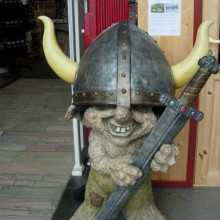
09:14 - Best of NG - Are you a Viking?
Best of NG - Are you a Viking?
with Mark Jobling, University of Leicester
Kat:: My next selection dates from September 2013, but it covers a topic that dates back much further - that of genes and genealogy. In recent years we've seen an explosion in people digging into their family history, tracing their family trees. And with the advent of cheap gene sequencing, there's a new field of recreational genetics springing up, as people try to unpick their genetic ancestry. But what can our genomes actually tell us about where we came from and who we are? Professor Mark Jobling, at the University of Leicester, is a leading expert in human genetics and genealogy, so I asked him for some answers.
Mark - Well, the human species is remarkable for the fact that it covers almost the entire habitable surface of the Earth and has very, very large numbers. But that situation has arisen in a very short time compared to other species. So, it's only about 200,000 years since our species originated. During that time, there's been a migration. We know from various lines of evidence that humans originated in Africa about that time and then migrated into the old world. Thereafter, there were several further migrations. In more recent years, we've had contact between populations that have been separated for very long periods of time.
Mark - So, we're interested in looking at modern human genomes, the genetics among human populations and trying to disentangle various aspects of those migration histories. But I guess you could ask, "Well, don't we know a lot of that anyway from history and other sources?" The answer is, we know some things, but not enough. There's also often conflicts between different sources of evidence. So, genetics has something new to bring to try and to understand how we ended up in the way we are.
Kat - And what sort of things you're actually looking at when you talk about the genetics of different populations? What sort of things differ genetically between people?
Mark - Well, the first thing to say is that, people are all very, very similar to each other indeed. That's the important thing to stress. We always talk about the differences, but in fact, we're 0.08% different. We are a very uniform species. So, we focus on the very small number of differences. Beyond that, we look at differences between populations in order to try to understand when particular groups of people move from one place to another.
And so, we might think for example of the migration of the Jewish diaspora. People originated and moved about 2,000 years ago across Europe or the migration of the Roma people - sometimes called gypsies. They originated about 1,000 years ago in northern India and then migrated across Europe. Or more recent events like the transatlantic slave trade which brought African people together with people who've been living for thousands of years in the Americas and with people previously been living in Europe. So, there have been a lot of these complex mixture events and you can look at differences between populations - these very small differences - to try and illuminate those events.
Kat - What sort of things can you tell? What sort of resolution can you get? Can you tell for example that a whole bunch of people all came from one family, one starting person for example?
Mark - Well, it depends which bit of the genome you look at. So, you can look at individual genomes. Good examples are the Y-chromosome which passes from father to son or mitochondrial DNA which passes from mothers to all of their children. So, those form what are called gene genealogies. They're not necessarily referring to genes themselves, but you can look at the pattern. You can form a family tree of all of those sequences in the world and look at the pattern of those in different populations. So, that has some advantages in that it's rather simple to understand, but some disadvantages because as you said, you're looking in the case of all Y-chromosomes and essentially, one pedigree. So, that all modern Y-chromosomes descend from one single man who lived at some point in the past. Similarly, all mitochondrial DNAs descend from one woman who lived at some point in the past. So, those are only telling us about single ancestors in any one person's actual genealogy. So, there's simplicity there which gives advantages and disadvantages.
So now, we have whole genome methods of trying to understand diversity and that again brings advantages and disadvantages. So, on the one hand, we're looking at the entire genome or 'snips' (SNPs) that are distributed across the genome and that gives us many different evolutionary stories. Almost each snip has a different story to tell. We're looking at the averaging of those and that gives us a kind of a general picture of how populations are related together, but it doesn't tell us about individual ancestry.
Kat - Because that's something that people are very interested in. There's a whole industry of people looking at their family history, their family trees, trying to work out where they came from, where their origins were. What sort of things are going on in this kind of area of recreational genetics that intersect with the sort of work that you do?
Mark - Well, you're right to say that people want to know where they came from or where their ancestors came from and there's a big problem there because each one of us has two parents and they have two parents each, and so on back in time. So, if you go back just a few hundred years, the number of notional ancestors anyone of us had is much greater than the current population of the entire planet. So, we have many ancestors in common which explains why that number thing happens. But at the same time, for any one of us to say, "Well, where did my ancestors live, say, 1,000 years ago?" is a meaningless question because they must have lived in many, many different places. So, the simplest and most accurate answer to that question is everywhere.
So, there's a tension there between the public wanting this kind of ancestry story, the sort of, 'who do you think you are' story about their genealogies, and what genetics tells us about ancestry which is that it is complex, multifaceted and we have many ancestors. So again, that's why there's been this focus, going back to mitochondrial DNA and Y-chromosomes. That's why those have become such a focus because there, there really is a single ancestor at some point in time that you can point to and say, "This man is my great, great, great, times 'n' grandfather or this woman is my similar grandmother." And there's a great attraction to that. What it leads to is a focus on those two kinds of ancestors - the patrilineal and matrilineal ancestors - simply because they're easy to understand and think about. But they're no more special than any other of the ancestors that we would've had at that time.
Kat - They're just the ones we can spot.
Mark - They're the ones we can spot, exactly. I think that there's burgeoning in the number of companies doing genetic ancestry testing and I think some of them, they try and oversimplify things, such that they're saying something about somebody's ancestors from a single lineage and that's a bit of a slightly misleading to do, I think.
Kat - So, given that you're very well-known for working in the area of genetics and population studies, do people often contact you with questions about their family history, about their genealogy? What are the most common things that people ask you about?
Mark - Yes, we do get a lot of queries. I mean, some of them are quite surprising and amusing. So, there's a strong desire among men in particular to be connected to the Vikings in the past. More broadly and seriously, we get quite a lot of questions from people who phone up or send emails about events in their own family history. Particularly common is people who found they've been born by artificial insemination by donor. So, they have no information about their father or people who turn out to be adopted. And again, there's no information.
Kat - And finally, have you had your genome analysed in any way and what did you find in it if you did?
Mark - Well, not very comprehensively. No, I act as a kind of control DNA sample in every experiment that's done in the lab. So, I know my Y-chromosome type which is called I1a and it's one of the ones that people regard as a Scandinavian lineage so that much I can tell you. The rest of my genome, I can't really tell you anything about. I've showed a surprising lack of interest in my own genome, given that what we do is work on everybody else's.
Kat

17:02 - Best of NG - Sexy genes
Best of NG - Sexy genes
with Judith Mank, UCL
Kat:: Another interview that has stuck in my mind is the chat I had with Professor Judith Mank from UCL back in July 2013, on her work about the genetics of sex determination. Genetically speaking, our human species is broadly divided into male and female, determined by our sex chromosomes - XX for females and XY for men, although there are people whose chromosomes don't strictly conform to this, for various reasons. But the way that we do sex - at least on a genetic level - isn't the only way to do it. I started by asking Judith what, biologically speaking, do we actually mean by "sex"?
Judith - So, sex can be two things. So, it's the act of actual - it's called syngamy, the combination of egg and sperm, but related to that, what we said is the evolution of sexual dimorphism so how you get separate males and females. Males and females often look different, they act different, and that's why we study it in group.
Kat - A lot of us are familiar with the idea that humans have an X and a Y chromosome if you're a man, and XX, if you're a female. Is this the only way of doing it?
Judith - No, there's a million different ways. There are a lot of fish that actually flip partly through their life. So, they start out as one sex and when there's some sort of cue, they flip to the other one. Interestingly, it seems that within a couple of hours of the cue, their brain starts changing. They start acting like the other sex and it takes about 3 days after that for the gonad to follow.
Kat - Their body completely changes as well to the other gender?
Judith - Yep, and they start reproducing within about 3 days with the other sex. There are a lot of animals that are XY like mammals are, but different sort of independent X and Y chromosomes. We study in our group, we do a lot of work on birds which are Z and W. So, in that case, the male has two Z chromosomes and the female has one Z and one W. So, the W is quite somewhere to the Y that you see in humans.
Kat - Now, this seems quite strange that there would be so many different ways of doing this in the natural kingdom. How has this arisen?
Judith - That's actually the big question at the moment to be honest. So, no one really understands how some things are fundamental as how you determine sex changes. The only thing that we do understand is this old idea of conservation - so, you've got the same sex determining system in most mammals. You've got the same system in birds. You've got the same system in fruit flies. That idea that sex should be conserved is clearly not true. So, you've got some systems like fish where within populations, you've got multiple mechanisms of sex determination and it changes very, very quickly. That seems to be much more common.
Kat - If you're going to have sexual reproduction, you need a male and female or two different things to make it work, producing eggs and sperm. Are there any inklings of maybe how these kind of mechanisms of the sex chromosomes have arisen at least in some of the animals or some of the creatures you studied?
Judith - So, there's a lot of theory. Not a lot of it is really well proved, but most people think that if you've got a gene that determines sex, say, a gene that makes you male. And there could be several different genes that might predispose you to being male, but if that gene is linked - is physically very close to another gene that confers some male benefit - so, if you have both of them, you're both a male and you're a very fit male, you're a good male then that sort of sends you along the path to having a Y chromosome. But if you have a gene that makes you female and that's close to another gene that makes you a very good female then that would sort of send you on the path to a W chromosome.
Kat - What is the advantage of actually having two sexes because you think about well, something like an amoeba where it just splits itself, it reproduces, seems to be kind of fine, bacteria seem kind fine? What is the actual advantages of having different sexes?
Judith - Well, there's two things. So one, some things have sex but don't have obligate sex. They don't always have to have sex. They can sometimes reproduce clonally.
Kat - Like a yeast?
Judith - Like a yeast, some fish, a lot of plants. So, occasional sex is useful in that it helps you adapt more to changing environments and to outpace parasites and things like that to sort of keep your immunity up.
Kat - So, you're kind of mixing your genes up, makes you a bit fitter?
Judith - Yep, exactly. Having obligate sex like we do means that you avoid any sort of inbreeding or you minimise inbreeding so if you can't mate with yourself, you avoid having two copies of a recessive deleterious alleles. In theory, the offspring are fitter, they do better, that's the idea.
Kat - One of the things I'm very interested in your work is the idea of conflict within the sexes. This isn't sort of the battle of the sexes - men versus women. This is kind of conflict between genes at this kind of level. Tell me more about that.
Judith - If you think about it in humans, men and women have - they only differ on the Y chromosome and the Y only has a few dozen genes at most. And so, for 99.99% of genes, they both have them. But yet, men and women look different, they act different, they have different interests, sort of as a sex and so, that means that the optimal function of any gene can differ between men and women. So, it's this idea of conflict over the optimal usage of a given gene.
Kat - So that the genes that you have on your sex chromosomes maybe kind of determine how the other genes get used?
Judith - Well, you can have conflict without sex chromosomes. So, there are lots of animals that have lots of conflict and don't have sex chromosomes at all. Conflict can be in any part of the genome. Any gene that codes a phenotype, some sort of form that differs between males and females. So, if you think about behaviour - so we work on birds a lot, males often find the highest point they can to scream their heads off, so the females notice them. And that's not great if a female does that because she doesn't get any benefit from it. Males don't really take any notice of it and it makes her much more conspicuous to predators. So, the gene that encodes that behaviour is under conflict. So, males want that behaviour, females don't. Males benefit from it, females don't. So, there's this conflict over what it causes.
Kat - Do we know anything about what helps to kind of establish which way you go with it? Is there a role of hormones? Is there a role of the environment, anything?
Judith - Hormones can kind of resolve this conflict in a way. So, if you get one of those genes under the control of a sex hormone, that means that it's only going to be expressed in one sex and that results all the conflicts. So, if they both got the gene, but only one of them uses it.
Kat - What for you is the thing that when you discovered it was like, wow, that's weird!
Judith - That changes by the moment, but I think the thing that I'm most obsessed with currently is the study we just did in turkeys. So, I didn't know about this until I went up and talked to a breeder. So, turkeys actually come in two male phenotypes, two male forms. So, there's this dominant male and then there's this subordinate male, and the dominant male and the subordinate males, they're actually brothers. All the brothers in a given clutch, the winter before they mature get together and they battle it out for who's going to become dominant. The dominant male has the sexually selected traits. It's got this big tail. It's got this iridescent plumage. He makes that really goofy gobbling sound. He has a snood and a wattle and a couple of other things. The subordinate male has most of those, but a little bit less. The subordinate males actually advertise for females with their dominant brother and there's some evidence of having a lot of very attractive subordinate males actually pulls more females in, but they never mate. All the matings go to their dominant brother. They never try and buck the system, so they never and put off their dominant brother. We were interested in the gene expression patterns underlying this.
Kat - Because this is like a wingman basically - well, literally.
Judith - Wingmen, exactly yeah. It's this really bizarre system and I had no idea this was going on. And so, I went up to this breeder and Yorkshire and she showed me the way it works and then I started reading about it and it's amazing. It's also the least tractable system in the world. These things take two years to mature. They're big. They're mean. They're expensive. They don't want people. They're not ideal in that sense, but it's just fantastic. So, we were interested in sort of the gene expression differences between the dominant and subordinate male because both are male. But in some senses, the dominant male is a bit more male in terms of all these traits he's got. It was really amazing for thousands of genes. The subordinate male was a little bit less male in expression and a little bit more female. They only differed from the dominant brothers by a few genes, you know, very much. They're only like 4 or 5 genes that differed a lot, but across the spectrum of all 7,000 expressed genes, they showed these very subtle differences that affect the phenotype, sort of as an aggregate.
Kat - Almost like it's like kind of a third sex for turkeys?
Judith - Not quite, but if you think about sort of sex along an axis, they're clearly on the male side, but they're just a little bit less male. They're not intersex by any means. They can reproduce if they wish.
Kat - If they got the chance.
Judith - Yeah, exactly.
Kat

26:04 - Best of NG - Drunk flies
Best of NG - Drunk flies
with Karla Kaun, Brown University
Kat:: With my new year hangover finally fading, this next interview from January 2015 was on my mind. But somehow, however terrible I feel after a big night out on the booze, waking up feeling awful and swearing I'll never drink again, I somehow find myself back on the sauce again a few days later. It turns out that forgetting the horrible effects of drinking is something we share with tiny fruit flies. Karla Kaun, from Brown University in the USA, is training flies to associate a particular smell with an alcoholic tipple and figuring out how they switch between so-called aversive memory - when they recall how bad they feel - to appetitive memory, when they can't wait to get back to the fly pub.
Karla - So, what I study is memories for the intoxication experience. What I found is that even in flies, the initial effects of alcohol are always aversive, something like a hangover effect. But what's intriguing is, like going to the bar on a Friday and Saturday morning not feeling well, but wanting to go out again Saturday night, the long lasting effects of alcohol are appetitive. And what I'm interested in figuring out is, how are neural circuits mediating this effect and what the molecular mechanisms acting in these circuits to affect them.
Kat - Obviously, fruit flies don't go out to the pub, what's fruit flies' relationship with alcohol normally like? Are they big drinkers?
Karla - So, flies, like humans have a long natural history with alcohol. So, humans have been consuming alcohol for centuries and flies actually spend a good portion of their life and little concentrations of alcohol. They lay their eggs in fermenting fruit and in fermenting fruit of course are patches of moderate concentrations of alcohol. So, as larvae, they eat this alcohol and it's evolutionary advantageous to them. For example, a larvae that has a 6 per cent alcohol concentration in its body is less likely to be parasitised by wasps. So, what's very interesting also is that flies' effects to higher concentrations of alcohol are remarkably behaviourally similar to those in humans. They go through the same stages. At first, you get disinhibition and then you get a loss of locomotor coordination and then the flies will just pass out in the bottom of the vial. The time it takes for him to recover is almost the same as the time it would take us to recover.
Kat - How long does it take a fly to kind of go from, "I'm never doing that again" to "Yeah, let's have another drink.?
Karla - Well, with the parameters I tested, it's somewhere between 12 and 15 hours.
Kat - That's pretty good going. So, the next time that flies encounter alcohol, they think, "Yeah, this is great! Let's party!"
Karla - Pretty much, yeah. They find the reward long lasting, so it lasts up to seven days which is a long time for a memory for a fly. They'll also walk over a 120 volt electric shock to get to the odour that was previously paired with alcohol. So, this suggests that it's an extremely appetitive and intense memory.
Kat - So, I'm sure some of us would deeply sympathise with that. But tell me then, you're trying to understand what's going on at a molecular level. What have you found out so far about how they form these different types of memories, the kind of, "Oh my God, no" and then the, "Yeah, let's do it again"?
Karla - So, what I think is happening is you're getting parallel circuits that encode both the aversive memory and the appetitive memory, and then you get feedback between these circuits. The appetitive memory can turn off the aversive memory circuit for example or potentially vice versa if something goes wrong. I'm interested in figuring out what inside of these neurons is affecting it and one of the molecules that I looked at is a regulator in the Notch signalling pathway. Notch is really important for maintaining long term memory. So, we're trying to figure out how alcohol affects this to potentially result in aberrant memory formation.
Kat - So, Notch is one of these kind of signals that tells cells what to do, what kind of cell to be, what to get up to.
Karla - Pretty much. It's a cell-cell signalling molecule. so, it's like an early signal that affects a lot of downstream effectors.
Kat - So now, you're kind of starting to understand some of the molecules that are involved in these different types of memory and how the, "Yes, let's do it" overwrites the, "Oh God! Never again" kind of thing. How are you going forward with this and do you think that there may be similar mechanisms at work in human brains?
Karla - So, I absolutely do think there are similar mechanisms affecting human brains. Notch signalling is actually one of the most well-conserved signalling pathways. It's been studied for over 100 years in flies now. And biochemically, things work extremely similarly. I'm interested in figuring out how to target different types of Notch signalling changes to different kinds of brain regions. I think this will be extremely informative for developing pharmacological treatments. There are currently treatments for cancer being developed for drugs in the Notch signalling pathway and I'm hoping that I'll be able to perhaps use some of these drugs to treat addiction-related disorders.
Kat - Could you make an anti-hangover pill?
Karla - I'll tell you what, I'll work on it. More realistically, what we'll probably try to do is decrease the really strong appetitive memories by enhancing the aversive memories, so that people don't crave alcohol quite as strongly.
Kat

31:12 - Best of NG - Making music, mice rage
Best of NG - Making music, mice rage
with Nell Barrie
Kat - As well as bringing you interviews with the some of the most fun and fascinating genetics researchers around the world, I'm always keeping an eye on the latest news from the lab. And although it's a few years old now, this news chat with Nell Barrie, from back in July 2012, still makes me smile...
Nell - First one that we thought was exciting was a really interesting study looking at the evolution of music and this was published in the PNAS and it was led by Robert MacCallum and Armand LeRoi from Imperial College and what they've done is essentially, they've got some random sections of - I guess you wouldn't even call it music - just notes, random notes put together.
And they're getting people to select them on the basis of what they like to hear, what sounds the most pleasant and then they're getting these little selected bits of music to mate together and make babies, and make new music by just randomly combining bits in the tune and they're going to see if that can lead to music evolving over time which is very interesting.
Kat - So, we can listen to a bit of this. So, we've got some of the tracks, the Darwin tunes as they're called. So here's the first track "Generation Zero". So, these are just randomly generated noises. And here, we have them after about 400 generations... And now, here after about 1,200 generations, quite like the sound of this one... And finally, after about 5,500 generations, so these are really quite long and developed now. Do you think this is really natural selection and evolution though?
Nell - I think it's a really interesting model, I guess, but it's not really the way that natural selection and evolution works with animals and organisms because you're basing the selection on one very specific criteria which is whether the particular person listening to it actually likes it and in reality, if you're looking at an animal in its environment, there's all kinds of other things that will act to select whether it fits that environment or not I suppose. And also, this isn't really over a long period of time because you normally look at how the environment changes over time, what does that do to the organisms within it.
Kat - Exactly, it's a very split second thing ' do I like this? Do I not? ' I think quite interestingly, they're all very major, quite bland really. I think if this is the future of music, I'm not sure about this.
Nell - No, it definitely sounds kind of like something out of Pacman maybe and I mean, I like it from that point of view and it does sound like real music I suppose, but it's not ' yeah, it's not going to set the world on fire any time soon.
Kat - Something that may ' well, set something on fire is a story that I saw in the journal of Neuroscience. This is from Marco Bortolato at the University of Southern California and this is looking at the genetics of rage. This is an absolutely fascinating story. What are the researchers been up to here?
Nell - Yeah, I really like this one because I can definitely identify with extreme rage at some points in my life.
Kat - You look so calm and peaceful all the time.
Nell - No, I definitely have that feeling occasionally where you just kind of snap and you get really mad. And perhaps, this is telling us a little bit about what might be happening in the brain especially in people, perhaps you have a real problem with controlling that rage and just can't manage to control it at all. By looking at a specific receptor which they think might be malfunctioning and over functioning perhaps in people who are very hostile, and they've looked in mice. So, this is really early stage stuff, but they found this receptor is faulty in mice that are very, very hostile and they think that this could have something to do with the same process in humans perhaps. So, maybe there could be a way we could fix the function of that receptor, return it to normal, and could that help us treat people who have rage problems maybe?
Kat - You know, we're not talking about people who like you, just get a bit of a strop on...
Nell - No, just getting a little angry is more like kind of serious problem with rage, isn't it? The other thing that struck me reading this is it's one of those studies where you're looking at a tiny part of what the brain does. And it's really interesting and it's telling you something but it really needs to be part of the whole thing, and when you're looking at things like behaviour, it's usually not simple as switching one thing on and off, and switching that behaviour on and off because there's so many different aspects to it, and they talk about risk factors as well.
So the way you're brought up, the kind of environment you live in when you were a child has a big effect on the type of rage response you might have to things. So, that really got to be taken into account as well, so it's really early days. But it's interesting to see how these things are similar in mice and humans I think.
Kat - I'd like to see a mouse with rage - eek!!
Nell - you can see videos of angry rats on the internet that I've seen. They've done some selective breeding and you get really, really angry rats who just attack people just on sight.
Kat - More than angry birds who just attack pigs.
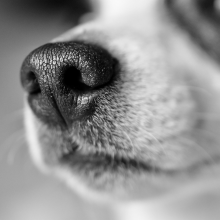
41:42 - Best of NG - Genes and Smells
Best of NG - Genes and Smells
with Stuart Firestein, Columbia University
Kat:: But first, it's time for a whiff of nostalgia from February 2014. Cheesy jokes aside, smell is one of the keys ways humans and other animals sense the world around them. Stuart Firestein, Professor of Biology at Columbia University in New York explained to me how our sense of smell works, and why it's so important.
Stuart - So it's quite a remarkable sense to begin with. One that in humans, we underestimate. There's generally this idea, I think, that people have less of a sense of smell or less dependence on smell than many other animals, that were not as good at it. Actually, that's not quite true. We're quite good at smell. When you test this carefully, the biggest problem with our sense of smell it turns out, in fact, is that we walk on two legs, so our noses are about five feet up in the air here and all the good odours are down within a few inches to the ground. That's why dogs put their nose right to the ground when they catch a scent.
But you know that we have a very good sense of smell because we use it in the sense of flavour, which is different from taste, sweet, sour, salt, bitter, but everything else is flavour and that's about 80% olfaction. And that's because when we put food in our mouth and we crush it, we send it up what's called retronasal pathway, the back of our throat, where it impinges very closely now on the olfactory receptors which are in our nose.
Kat - And what do we know about these olfactory receptors? How do they work? And what genes are involved in the sense of smell?
Stuart - Yes, they're quite remarkable as it turns out as well. So first of all, we smell a large number of molecules - hundreds of thousands conceivably. I mean, we know of many, many thousands and then there are new smells that pop up every day, you know, like, new car smell. I mean, it's a very clear smell, but we clearly haven't evolved something for that, so we can put blends together. So there are many, many smells. They're all small organic molecules.
And there are now a large number of receptors - these are these little proteins that sit in the membranes of the sensory neurons that are way up in the top of our nose. Those sensory neurons have these proteins in their membrane that bind to these odours much like a lock and a key mechanism, and then when they bind to these receptor, it depolarizes the cell, which they changes the cell's voltage, electrical characteristic, and that signals the brain that this receptor has located a particular molecule which is now an odour. And the brain somehow or another now interprets that to be a banana or a pear or a pile of dung or whatever it might be that the chemical is coming from.
The receptors themselves were first discovered as a large gene family by Linda Buck and what was remarkable about the discovery that made it worth the Nobel Prize perhaps is that it turns out to be an extremely large family of genes. Indeed, the largest family of genes in our genome.
Kat - How many are we talking about here?
Stuart - Well, so in most mammals, we're talking about something in the range of a thousand genes. To put that in some perspective, we now think having sequenced the whole human genome that the typical mammalian genome is maybe 25,000 genes. So now, a thousand of them are devoted to your schnozzola here, your nose, you know, that's remarkable. That's 2 per cent of your genome, between 2 and 5 per cent of your genome devoted to your nose. So in humans, it's a little bit lower in number. We actually have the thousand genes in our genome, but about half of them seem to be what we call pseudogenes, which means they've mutated in such a way that they are no longer, probably capable of making a functional protein, and so we get by on, let's say 500. And the next largest family of these receptors are the ones for serotonin, very important to psychological illnesses and things like that. And in the serotonin family there are 15 genes.
Kat - Wow!
Stuart - So compared to 500 for odour receptors or a thousand if you're a mouse.
Kat - So, what do we know about how cells in the nose choose which odour receptor that they're going to go with? How do they choose which one to switch on?
Stuart - Yes. This is probably the biggest question in the field right now. It's a remarkable observation that we know, but we have no idea what the mechanism is. So the observation is that each sensory neuron - you have about 10 million of them in this little tissue at the top of your nose - each one of these sensory neurons goes through the genome somehow and picks one of those genes and all of the proteins that it makes, which are millions of receptors are made from that one gene.
So, each cell is devoted to one particular receptor and therefore one set of odours, whatever odours that receptor binds. Not only are they - we say then monogenic, that they've picked on gene from, let's say the thousand possible genes that are spread all over the chromosomes. They're located on virtually every chromosome. So somehow or another, the cell has picked one gene. It's remarkable that mistakes don't seem to get made. I mean, a cell really does seem to pick this one gene and express all of its receptors off of that gene for its entire lifetime.
Kat - What do we know so far about what's controlling that choice and how these decisions are made and how the genes are picked and switched on?
Stuart - Almost nothing. Actually, I could say nothing. We could leave the almost out. There have been many theories. We've tried many things. Many laboratories have tried many things, but we haven't really got a very good handle yet on precisely what it is that was controlling them. It's taught to be probably some feedback mechanism. We do know this: if a cell chooses a pseudo gene one of these genes that's no good, that doesn't make a good protein, it will turn that off and go back and pick another one and then presumably, continue doing that until it finds a gene that makes a good protein and does so.
So the thought is, well, it must have something to do with the functional protein and then some feedbacks that says to the cell, "Okay, you found a good protein, turn off your gene choice mechanism and stop whatever you're doing, just make this protein." But we've never found that signal. So, the answer really is we don't know. There are lots of ideas, but we still don't know. It's a big question.
Kat - It seems a very, very mysterious sense. What do you still really want to know about it?
Stuart - Still, there are quite a few mysteries about it, that's true. We don't know really why it has such a strong effect on memory. The wiring in the brain is a little bit - is a bit unusual, I will say for a sensory system. It doesn't go through a piece of the brain called the thalamus, which all other sensory systems do. We don't know what that means. I'm just stating a simple anatomical curiosity. We have no idea if that's meaningful or not meaningful or anything.
The memory business is quite curious. It, I should point out that the memories that are revoked by olfaction always have a strong emotional content, so you remember the first day of school or first lover or the last lover, or something like that, you know? Or you are at grandmom's house, but it's not like you smell something and remember a page of text or an equation or something useful.
Kat - Unfortunately, yes.
Stuart - That's right. That doesn't seem to work, so there are always these emotionally tainted or strongly emotional memories. Now, we're not quite sure what that means either, but that's an observation that we find with them. They certainly govern a great deal of our feelings about things in very subtle ways often. I mean, people are always interested in pheromones and things like that, something you can spritz on yourself and you'll become super attractive.
But I will say, for example, that olfaction can have very strong negative effects in interpersonal relation. So you can meet somebody, find them quite attractive physically. Then you talk to them and now they're even more attractive intellectually and socially and all the rest of that. And then you finally, kind of, get up close to them, you know, for the first kiss or something and they have some off odour and that's it.
Kat - Yes.
Stuart - It's over, right? And you'll never get past that.
Kat - Yes.
Stuart - I don't know care how good all the rest of the stuff is, you just won't get past that. So we're very strongly attuned to that sort of thing, for sure.
Kat - That's what you'd like to unravel, the scent of a woman.
Stuart - Yes. That would be fabulous, and put it in a bottle.
Kat
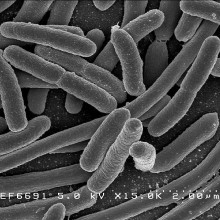
50:12 - Best of NG - Experimental evolution
Best of NG - Experimental evolution
with Tiffany Taylor, University of Reading
Kat - For my final interview, I've picked this one from July 2012, with Dr Tiffany Taylor from the University of Reading. she and her colleagues are busy manipulating bacteria and putting them through their paces, so see how they evolve in the face of considerable challenges.
Tiffany - I'm an evolutionary biologist and I'm interested in experimental evolution. So, what that allows you to do is it allows you to - I'm using microorganisms or fast-replicating organisms that allow you to follow evolutionary processes happening in real-time.
Kat - Because normally, when you think about evolution, you think about millions of years, population, stuff takes a long time. Give us an example of how many generations you can get through and what sort of timescale?
Tiffany - Well, that's the fantastic thing about bacteria is that they have a generation time approximately 20 minutes so you can get through vast amounts of generations very quickly and the population densities can reach huge scales in a very small space so you can keep large libraries of all sorts of mutants and you can grow them up. A great thing about it as well is that you can keep these mutants in suspended animation just by freezing them and then this allows you to compete evolved ancestral strains together and get those measures on like competition and fitness in different environments.
Kat - Can't even imagine doing that with humans, so we dig up some Neanderthals and have a fight with them.
Tiffany - Absolutely, yeah. So what you're doing is looking at survival of the fittest between like you say, fossils and highly evolved species and then letting them compete and fight, and seeing who wins.
Kat - What are you particularly looking into?
Tiffany - Well at the moment, I'm looking at the evolution of the novel genetic code. So what that means is that we're getting a bacterial cell, we're changing the code in some way and then seeing how the bacteria can evolve and adapt to this code over time.
Kat - You're talking about changing the genetic code. Does this mean you're changing the DNA or something else?
Tiffany - The way that the genetic code is read is in triplets. So, the genetic code is made up of different letters and each 3-letter codes code for different amino acid. So, for example, ATG is going to code for a specific amino acid. So if we change what that triplet code codes for, so it codes for a different amino acid, essentially, you're forcing the bacteria to read this genetic code differently.
Kat - And so, you change it and then they have to figure out what on earth to do with it?
Tiffany - Exactly. Then all we had to do is let them evolve over time just by transferring them to new environments and just then go back into the genome and have a look at what mutations have occurred to allow them to adapt to this new code.
Kat - And you don't really think of bacteria as being much under environmental pressure. What sort of different environmental pressures do you put them under?
Tiffany - Well in the case of this one, the only real environmental pressure we're putting them under is that we're linking this trait to the production of a certain enzyme which is going to be vital for their survival in the environment because it's going to have such a large fitness decrease associated with changing the code. You need to put a selective pressure which means it's going to maintain this new code within the bacteria.
Kat - But basically, if they can't evolve away of getting over this, they're going to die pretty fast.
Tiffany - Exactly, yeah. Bacteria are very good at overcoming problems. I mean, they've been here for about 3 billion years, so I think that they probably will find a way and it is a bit of an interesting project that we really don't know what we expect to see. But I would expect to see changes quite quickly and probably, quite inventive changes that we haven't thought of before.
Kat - And you're looking at bacteria, you're making them go through multiple generations, and mutating them. Are they ever going to change into anything other than bacteria because when you look at the billions of years of life on earth, we've seen species gradually evolve into different things? Are they going to change into something that's not bacteria?
Tiffany - It's not possible in the timescales that we're talking about. I mean, bacteria do replicate very quickly, but to see these sorts of changes in what we call the macro-evolutionary scale, to actually see them speciate, takes an incredibly long time and much longer than anyone's career.
Kat - Certainly longer than your post-doc!
Tiffany - Absolutely!
Kat - Tiffany Taylor, from the University of Reading.

54:09 - Best of NG - Astronaut genes
Best of NG - Astronaut genes
with Frank Jiggins, Cambridge University
Kat - As well as news and interviews, we're always happy to try and answer your genetics questions. And with Commander Tim Peake currently holed up on the international space station, what better query to revisit than this one from June 2012 from @ironmunya on Twitter, who asks "Are there genes that make people better suited to become astronauts?"
To answer, we spoke to Dr Frank Jiggins from the Department of Genetics at Cambridge University.
Frank - Certainly, astronauts suffer from all sorts of health problems and most medical conditions have some genetic component, so there's genetic variation amongst individuals as to how likely they are to develop these conditions. So at least in theory, you should be able to predict which individuals are likely to develop these conditions and they'd make the better astronauts. So for example, one of the problems is the effects of low gravity which can result in muscle wasting and reduced bone density, and we know from people on Earth that there's a lot of genetic variation in these traits. About 20 genetic variants have been identified that affect bone density. So you could maybe pick individuals which had the better genetic variants and maybe they'd be less likely to develop these conditions.
Another problem that an astronaut might develop is space adaptation syndrome which is a type of motion sickness. This generally only affects about half of astronauts. So it's possible that maybe there's a genetic component there and if we could identify it, we might be able to predict those astronauts which would develop this problem.
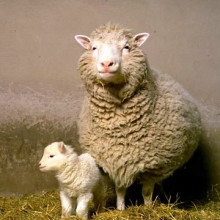
55:44 - Best of NG - Callipyge
Best of NG - Callipyge
with Kat Arney
Kat:: And finally, it's time to revisit my favourite gene of the month - one of the first in the series from back in May 2012. Move over Kim Kardashian, because our gene of the month is the curvaceous Callipyge, Greek for "beautiful buttocks". It was first spotted back in the early 1980s on a farm in Oklahoma, when the farmer noticed some sheep in his flock with particularly big, muscular bottoms. Tracking down the Callipyge gene itself turned out to be quite tricky, because it is inherited in an unusual way known as paternal polar overdominance - the only known example of this phenomenon in mammals. Animals only get big bums if they inherit a normal copy of the gene from their mother, and a version from dad that has just one single DNA letter change.
Agricultural researchers are very interested in Callipyge because the mutation enables sheep to convert food into muscle 30 per cent more efficiently than their small-bottomed siblings. And as well as the potential for breeding meatier livestock, scientists think it could also shed light on human size and shape, helping our understanding of the genes (with a g) that affect whether we can fit into our jeans (with a
- Previous New Leukemia Therapy
- Next Why do we have pubic hair?










Comments
Add a comment